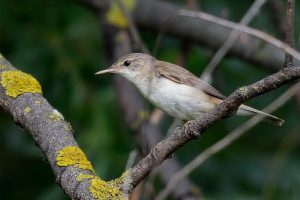Report on the Pan-European Common Bird Monitoring Scheme, June 2018
June 11, 2018
This report summarizes the activities of the Pan-European Common Bird Monitoring Scheme (PECBMS) between July 2017 and June 2018, mostly under the European Commission grant “Towards a new generation of Wild Birds Indicators”.
Publication of new European species trends and common bird indicators
European species population trends and indices have been produced for the time period 1980–2015. A reliable European index was produced for 170 species. In 2017, we have added one new species, the Eastern olivaceous warbler Iduna pallida, to the list of European common birds.

In the 2017 update, the reliable European index was produced for Eastern olivaceous warbler Iduna pallida for the first time. Photo: Radovan Václav
The species indices were used for computation of European wild bird indicators, for the same time period 1980 – 2015. The indicators are computed for Europe and its regions (West, North, Central & East and South Europe), and EU, New and Old EU states for common farmland, common forest, and all common birds. The European species indices and common bird indicators have been published at the website in November 2017. Altogether, 28 countries provided their data for this update.
TRIM in R
The program TRIM, TRends, and Indices for Monitoring data, a program used to determine species population trends, was rebuilt by Statistics Netherlands as a package for the freely available and widely used open-source program R. RTRIMcontains the same methods and models for nature monitoring data as the original versions of TRIM. It can work with the same input data and produces the same output data, but as a package in R, it can easily be integrated in other R programming processes. Also, a shell for RTRIM has been developed by Statistics Netherlands, which makes it easier to process large batches of species with specific model parameters at once.
PECBMS publications
In January we have published a new leaflet called “State of common European breeding birds 2017”. In a concise form, it introduces the population trends of 170 common European breeding birds from 28 countries, for the time period 1980–2015. It also shows the three European wild bird indicators for common farmland, common forest, and all common species. We chose to highlight the greenfinch on this leaflet as an example of a species that is stable on a European scale but has highly contrasting trends in the European regions. The leaflet is downloadable in PDF via the website and has also been distributed in our network.

Leaflet “State of common European breeding birds 2017”.
An oral presentation was given by Petr Vorisek at the First Russian Ornithological Congress in February 2018, which was followed up by useful discussions on the development of common bird monitoring in Russia.
Use of PECBMS outputs in policy
The 2017 update of the EU indicators has been sent Eurostat in March, to be published on their website. The European and EU indicators until 2015 were also used for the update of the SEBI indicators at the EEA website.
Collection of national species indices
Regular collection of updated national species population trends and indices has started in May 2017, a request for the data until 2016 has been sent to the coordinators of national and sub-national monitoring schemes. We have asked for data on the same 170 common bird species for which we produced a European index in 2017. The next update of European species trends and common bird indicators is planned to be published in autumn 2018. In addition to the regular request for national species indices, we have asked the national coordinators for an update of site-level data, to be used for research purposes, both internally within PECBMS and in cooperation with external researchers.
Maintain and update the network of cooperating organizations and individuals
We maintain an extensive network of cooperating organisations and individuals across Europe. We currently have 158 contacts from 47 countries or territories in our mailing list, including coordinators of national monitoring schemes, EBCC national delegates, and BirdLife partner organisations as well as policy people and decision-makers.
New website and newsletter
We are preparing a new and improved PECBMS website. The structure and overall layout of the site have been transformed to be more attractive, up to date, and user friendly. The new website is scheduled to be online during summer 2018. Also, we have developed a new electronic newsletter, produced on behalf of the EBCC, and informing on related projects EBBA2 and EBP, too.
This new, quarterly newsletter has been sent out to our network already three times and was received positively. It is based on the outputs of a previous survey called “Help to improved PECBMS publication strategy” which we have spread in 2014 among 321 respondents. Most of them preferred to be informed regularly in the form of an e-mail newsletter.



